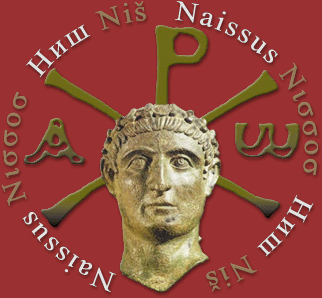

International Symposium of Byzantologists
NIŠ AND BYZANTIUM XXIV
"1700 years after the First Ecumenical Council of Nicea: 325 -2025"
S U M M A R Y
June 3 (Tuesday)
5:30pm – Ceremonial Opening
Oficirski dom, Orlovića Pavla 28a - Vocal Ensemble "Konstantine"
Cocktail: Niš University Hall
Chairman: Dr. Irena Ljubomirović (Niš)
- 6:30–6:45pm – Dr. Renate Johanna Pillinger (Vienna)
Selected Pictorial Representations of the Concilium Nicaenum in 325 AD
- 6:45–7:00pm – Dr. Antonio Pio Di Cosmo (Modena)
The Council and the Faces of 318 Fathers
- 7:00–7:15pm – Nadežda Rakocija, Dr. Miša Rakocija (Niš)
Architectural Features in Krševica
- 7:15–7:30pm – Dr. Obraztsova Ksenia (St. Petersburg)
Passageway Behind the Altar in Early Christian Architecture
7:30–8:35pm – Screening: European premiere of the documentary "Cyril and Methodius - Enlighteners of the Slavs"
8:35pm – Discussion
Dinner
June 4 (Wednesday)
Chairman: Deacon Dr. Ivica Čairović (Belgrade)
- 9:00–9:15am – Dr. Dražen Perić (Belgrade)
Saint Athanasius and Christocentric Anthropology
- 9:15–9:30am – Dr. Ivica Čairović (Belgrade)
Holy Fathers at Nicaea (325)
- 9:30–9:45am – Slaviša Tubin (Bijeljina)
Change of Ethnic Bishops at the First Council
- 9:45–10:00am – Dr. Dragoljub Marjanović (Belgrade)
Old Testament Motifs in Life of Patriarch Nicephorus
- 10:00–10:15am – Dr. Jasmina Šaranac Stamenković (Niš)
Ecaterine of Bulgaria in Psel's Letter
10:15–10:30am – Discussion
Chairman: Dr. Jasmina Šaranac Stamenković (Niš)
- 10:30–10:45am – Dr. Branko Radovanović (Šabac)
Saint Sava’s Relics as Axis Mundi
- 10:45–11:00am – Dr. Ralitza Bazaytova (Sofia)
St. Nicetas of Remesiana – Unitor of Europe
- 11:00–11:15am – Dr. Predrag Dragojević (Belgrade)
Lazar Mirković and Christian Morality
- 11:15–11:30am – Dr. Davide Bianchi (Vienna)
Christian Imagery Near Sirmium
- 11:30–11:45am – Dr. Svetla Petrova (Sandanski)
Mausoleums along Struma River
Chairman: Dr. Lars Ramskold (Stockholm)
- 11:45am–12:00pm – Dr. Vassil Tenekedjiev (Varna)
Architectural Components from Marcianopolis
- 12:00–12:15pm – Dr. Lars Ramskold (Stockholm)
Enigmatic Constantine Bronze Emission
- 12:15–12:30pm – Dr. Gianluca Olcese (Wrocław)
Council of Nicaea and the Western Calendar
- 12:30–12:45pm – Dr. Irena Ljubomirović, Nenad Radulović (Niš)
Nicaea and Serdica Councils
- 12:45–1:00pm – Darjuš Samii (Novi Sad)
Eastern Christian Pilgrimage in 4th Century
- 1:00–1:15pm – Dr. Katarina Mitrović, Vojislav Živković (Belgrade)
Byzantine Emperors in Niš
1:15–1:30pm – Discussion
1:30–3:30pm – Lunch break
Chairman: Dr. Dragoljub Marjanović (Belgrade)
- 3:30–3:45pm – Igor Stamenović (Niš)
Depositeria della Crociata
- 3:45–4:00pm – Dr. Ergün Lafli, Dr. Maurizio Buora (Izmir, Udine)
Byzantine Inscriptions from Izmir
- 4:00–4:15pm – Dr. Nino Sulava (Tbilisi)
St. Maximus the Confessor
- 4:15–4:30pm – Dr. Vasilj Jovović (Nikšić)
First Council in Montenegrin Journalism
- 4:30–4:45pm – Ziran Guo (Athens)
Palaeologos and Chinese Renaissances
- 4:45–5:00pm – Dr. Lidija Kovačeva (Skopje)
Magical Power in Religious Discourse
- 5:00–5:15pm – Dr. Ioannis Sisiou (Kastoria)
Old Layer of Painting in Kastoria
5:15–5:30pm – Discussion
Chairman: Dr. Jehona Spahiu Janchevska (Skopje)
- 5:30–5:45pm – Dr. Branislav J. Cvetković (Jagodina)
Imagery of Theoktistos
- 5:45–6:00pm – Dr. Sasho Korunovski, Dr. Elizabeta Dimitrova (Skopje)
Church Under Orta Mosque
- 6:00–6:15pm – Dr. Franc Curk, Marija Curk (Niš)
St. Roman Iconostasis
- 6:15–6:30pm – Dr. Nada Helou (Byblos)
Frescoes of Church of Saint George
- 6:30–6:45pm – Dr. Anđela Gavrilović (Belgrade)
Saint Healers in Patriarchate of Peć
- 6:45–7:00pm – Dr. Bojana Stevanović (Belgrade)
Female Saints in Rečani
- 7:00–7:15pm – Dr. Jehona Spahiu Janchevska (Skopje)
Wall Paintings of St. Demetrios in Trebino
- 7:15–7:30pm – Julijana Marković (Belgrade)
Church of St. Petka in Malča
- 7:30–7:45pm – Dragana Radović (Podgorica)
Crmnica Churches with Two Altars
- 7:45–8:00pm – MSc Mimica Velova-Graorkovska (Skopje)
Scupi – The Mass Grave 2694
- 7:45–8:00pm – Dr. Elena Kostić (Thessaloniki)
Two Bilingual Painters from Astrapas Workshop
8:00–8:15pm – Discussion, End of Working Session
June 5 (Thursday)
- 9:30am – Reception at Niš City Hall
- 10:00am–2:00pm – Tour of cultural monuments: Basilica of the Martyrs, Early Christian Necropolis (Jagodin Mala), Archeological Site Mediana

![]()


